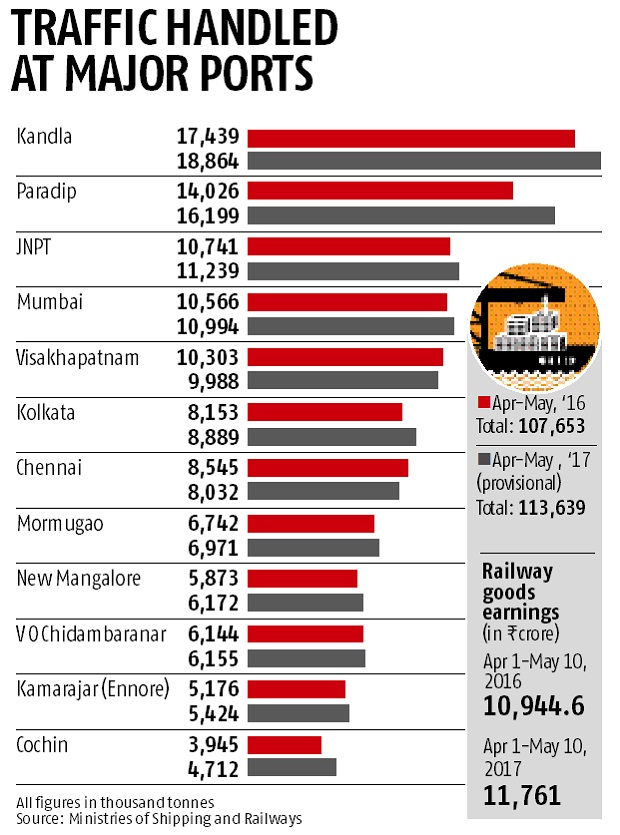Fuel demand, rail freight traffic and cargo movement at major ports grew in April-May this year, thanks to a low base.
The total cargo handled at major ports was up 5.5 per cent at 113.6 million tonnes (mt) during April-May 2017. The Ministry of Shipping officials said a slew of measures adopted at the ports had yielded results.
However, the pace of growth in the two months has slowed, if compared to the previous year. During April-May 2016, major ports handled 108 mt of cargo — growth of 6.3 per compared to 5.7 per cent in the same period in 2015-16. This indicates economic revival has been slow.
The latest data from the Indian Railways show that revenue from goods traffic increased 4.9 per cent to Rs 11,761 crore during April 1 to May 10 this year from Rs 10,944 crore in the same period last year. On the other hand, fuel demand saw a 5.4 per cent rise in May, compared with the same period last year.
According to the data released by the Petroleum Planning and Analysis Cell (PPAC), the overall consumption of fuel was 17.79 mt in May. Petrol sales for the period increased 15.3 per cent and liquefied petroleum gas (LPG) sales rose 11.6 per cent, compared to the same month last year.
“Increase in fuel demand is a sign of revival of the economy. This shows India is slowly getting out of the impact of demonetisation,” said Dhaval Joshi, research analyst at Emkay Global Financial Services. “There is no substantial reason for the rise in (port) cargo but it is because of the low base effect,” said Abhaya Agarwal, partner and PPP leader, EY India.
The Kandla Port handled 18.8 mt cargo, followed by Paradip (16.2 mt) and JNPT (11.2 mt).
Maximum business for the Kandla port came from petroleum, oil and lubricants or POL (10.49 mt). Other major commodities that were handled included iron ore, other liquids, coking coal and thermal coal.
Though port-wise performance has been similar to last year, with Kandla port traffic at 17.44 mt, Paradip at 14.03 mt and JNPT 10.74 mt for April-May 2016, the Ministry of Shipping had earlier said it had initiated measures to improve the performance of the ports.
These include mechanisation of the terminals, improving the TAT (turn-around time), quick evacuation of cargo, expansion of infrastructure and skill development of employees.
For both ports and the railways, coal volumes continue to be a concern since better availability of domestic coal has slowed down imports. There was a decline of 5 per cent in coal volumes at the ports in May 2017.
It was the only commodity that showed a decline. Growth was mainly driven by iron ore which rose 33.3 per cent in the first two months of the current year over last year, while POL grew 6.5 per cent and containers 6.4 per cent.
Nevertheless, April was the fourth consecutive month for the railways when volumes rose — a trend last seen in 2015.
Growth in April 2017 stood at 4.6 per cent. In the previous three months, freight volumes grew in the range of 0.3-7.7 per cent. The volume growth reflects increase in demand for commodities by domestic industry, said an official.
Container freight, which includes both domestic and export-import services, increased about 9 per cent from a year ago on a tonnage basis. During the last financial year, though the railways saw the highest ever loading of 1,109 mt, it was not much of an improvement in terms of growth. The freight volume was 1,104 mt in 2015-16 and 1,095 mt in 2014-15.
“For the last few years growth in railway freight traffic is static. Though ambitious targets are being set by the government, they are unable to meet that owing to less coal traffic. This financial year also, freight traffic will be affected following the closure of rail line in Jharia region, which may cut coal traffic by at least 25 mt, leading to a revenue loss of Rs 25,000 crore,” said a former Railway Board member.
Similarly, in terms of iron ore, traffic has slowed down. “There were years when additional rail freight traffic was in the range of 60 mt, when coal contributed around 60 mt. Now, cement and iron ore traffic is also declining,” he added.
Industry insiders say part of the increase in the first two months of the financial year could be because of the lag effect of lower demand in earlier quarters. They, however, point to the indicative pick up in manufacturing going forward though concerns relating to goods and service tax might create another uncertainty.


)
